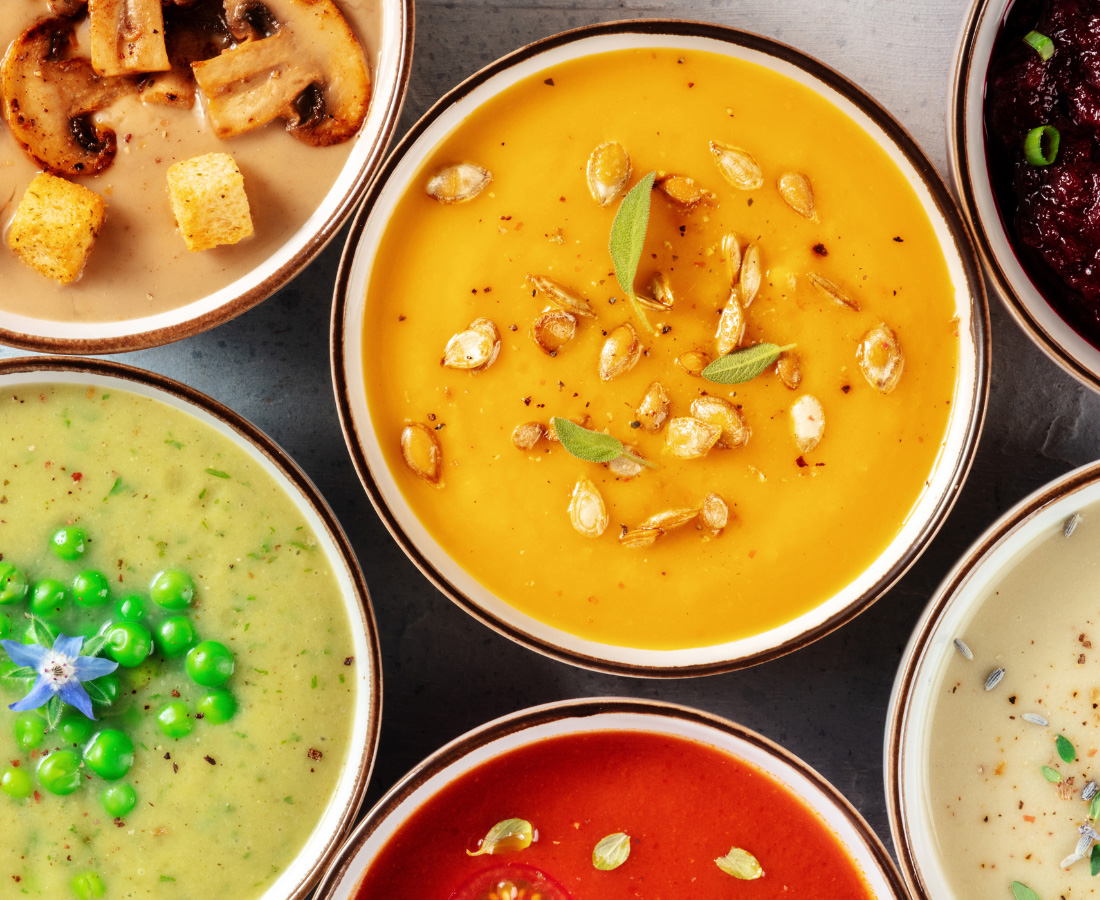How to Make Soup Without a Recipe

Soup is an age-old way to use leftovers, half empty jars of food, cooked meats, and limp vegetables. Transforming these foods into a delicious, nourishing bowl of soup is easier than you think, especially when you follow our simple steps.
Being able to make soup without a recipe is a game changer! You’ll be a souper hero with the power to prevent food waste and use whatever is in your fridge. Grab your pot and get ready to create your own signature soup.
Start With a Plan and Flavour Theme
Look in your fridge and pantry to see what needs to be used. Think about what spices, oils, condiments, and frozen foods you have that could complement your leftovers, veggies, and proteins. For example, if you have leftover spaghetti and meat sauce with a half jar of salsa, some sweet peppers, and wilted spinach you could pair that with herbs like basil, oregano, and parsley. If you have cream, cooked potatoes, cheese, and leftover seafood, consider a chowder using the same spices used for the seafood dish. If you have sweet potato, lentils, half a jar of curry paste, and cilantro consider using coconut oil, cumin, turmeric, coriander, and fresh cilantro for a creamy pureed soup.
Not everything you have will fit perfectly with your theme – that’s okay. You’re making a one of a kind special, so go ahead, add those green beans to your seafood chowder!
General Cooking Steps
Now that you have a general flavour profile and style of soup in mind, it’s time to get cooking. Here are the general steps to create a delicious soup with what you have.
- Choose and Heat Fat. Fat builds flavour, prevents food from sticking, and brings out the essence of aromatics. Choose whatever you have on hand, like canola oil, olive oil, bacon drippings, butter, etc. Use more flavourful oils like sesame oil or coconut oil only if they fit your theme. Allow your fat to heat up before adding ingredients.
- Sweat the Aromatics. Choose the classic trio of onions, celery, and carrots or add extras like garlic, ginger and cilantro stems if they work with your theme. The goal is to soften these aromatics to release their full flavour, but not to brown them, which can make them taste bitter. Use the standard ratio of 2 parts onion, 1 part carrot and 1 part celery, or just follow your gut.
- Heat Hardy Herbs and Spices. Add in dried herbs, spices, and hardy fresh herbs like thyme, rosemary, and oregano before adding liquid. Heat on medium for a minute until you can smell their aroma. This is when your kitchen is going to smell so good!
- Add Hardy Raw Vegetables. Add about 1-2 cups of hardy vegetables like potatoes, beets, rutabaga, carrots, parsnips, celeriac, winter squash, broccoli, cauliflower, mushrooms, etc. to give them plenty of time to cook. Cut into small chunks and add to the pan just a minute before adding the liquid.
- Add the Stock. Use a good quality stock that matches the theme of your soup. Of course, we think homemade stock made with leftovers and trimmings is the BEST! Try this Turkey Soup Stock from our Food Waste Champion Christine Tizzard.
At this stage you can also add other sauces or condiments you may have in the fridge or freezer. Consider things like half jars of salsa, tomato sauce, spaghetti sauce, pizza sauce, curry paste, diced tomatoes, butter chicken or masala sauce, coconut milk, etc.
A good rule of thumb is to add enough liquid to cover your vegetables by one inch. - Add Acid & Flavour Boosters. A splash of vinegar, lime or lemon juice, wine, or beer can really boost the flavour of your soup. Add a tablespoon with the stock and a little more at the very end if needed to liven up your soup.
Other flavour boosters you can add with the stock include bay leaves, lemon grass, soy sauce, fish sauce, miso paste, Worcestershire, mustard, etc. And don’t forget the Parmesan rind you’ve been keeping in the fridge. Never toss those rinds, you can add them into any simmering dish for extra umami flavour! - Simmer. Bring your soup to a boil, then reduce to a simmer (gentle bubbles breaking the surface) and let cook for 15-20 minutes until vegetables are fork tender. Extended boiling destroys flavour and proteins, so keep it at a gentle simmer.
- Add Additional Ingredients. Time to add leftovers, canned beans, cooked meat, leftover cooked grains and frozen/cooked/tender veggies like sweet peppers, wilted greens, tomatoes, peas, green beans, frozen spinach, corn, etc.
To prevent them from losing their colour or overcooking, only cook until heated through, about 8-10 minutes. - Taste & Adjust. Taste and adjust the seasoning and consistency of your soup. Add extra herbs and spices to create the flavour you want. And, if needed, add more broth, water, milk, cream, coconut milk, etc.
If you want to thicken your soup, create a cornstarch slurry in a separate bowl (important to prevent lumps) and gradually add to soup while stirring constantly, bring to boil for one minute to thicken. Add more as needed, boiling after each addition.
And finally season with salt and pepper. To avoid salty soup, add salt only as needed just before soup is finished. - Finish it Off – Once it’s off the heat, add a finishing touch with fresh herbs, yogurt, cheese, a squirt of lemon, a dash of nutmeg, or some crunchy croutons or garlic bread chips made from stale bread.
What About Pureed Soup?
For a smooth, totally pureed soup, add extra beans, potatoes, squash, or sweet potatoes during the cooking process. Puree with a stick blender before the final tasting. Add extra liquid as needed.
For a thick and chunky soup, puree the soup before adding the additional ingredients. If you’d like, you can take out some of the hardy vegetables before pureeing the rest. You’ll need to add extra liquid with the additional ingredients to reach the desired consistency.
For a creamy soup add evaporated milk, coconut milk, shredded cheese, or cream (low fat milk will curdle) to the soup at the very end and gently heat through.
Ready to give it a try? We know you can do it! But, if you prefer a more detailed recipe, try some of these:
Glorious Beet Greens Soup – use up your produce tops
Chicken Noodle Soup – great for leftover poultry
Tomato Butter Bean Soup – use up extra tomato products
Spicy Root Vegetable Soup – ideal for any type of root vegetables
Now that you’ve cleared out some of the food in your fridge – why not take a moment to clean and organize it? A clean and well-organized fridge is not just about safe food storage, it can also prevent food waste and save money. Use our Storage Guide for the best way to store different foods and keep them fresh.
We want to know – what’s in your fridge right now? Could you pick a flavour theme and create your own signature soup? We’d love to see what you come up with, share your photos and ideas with us on Instagram at @lovefoodhatewasteca.


